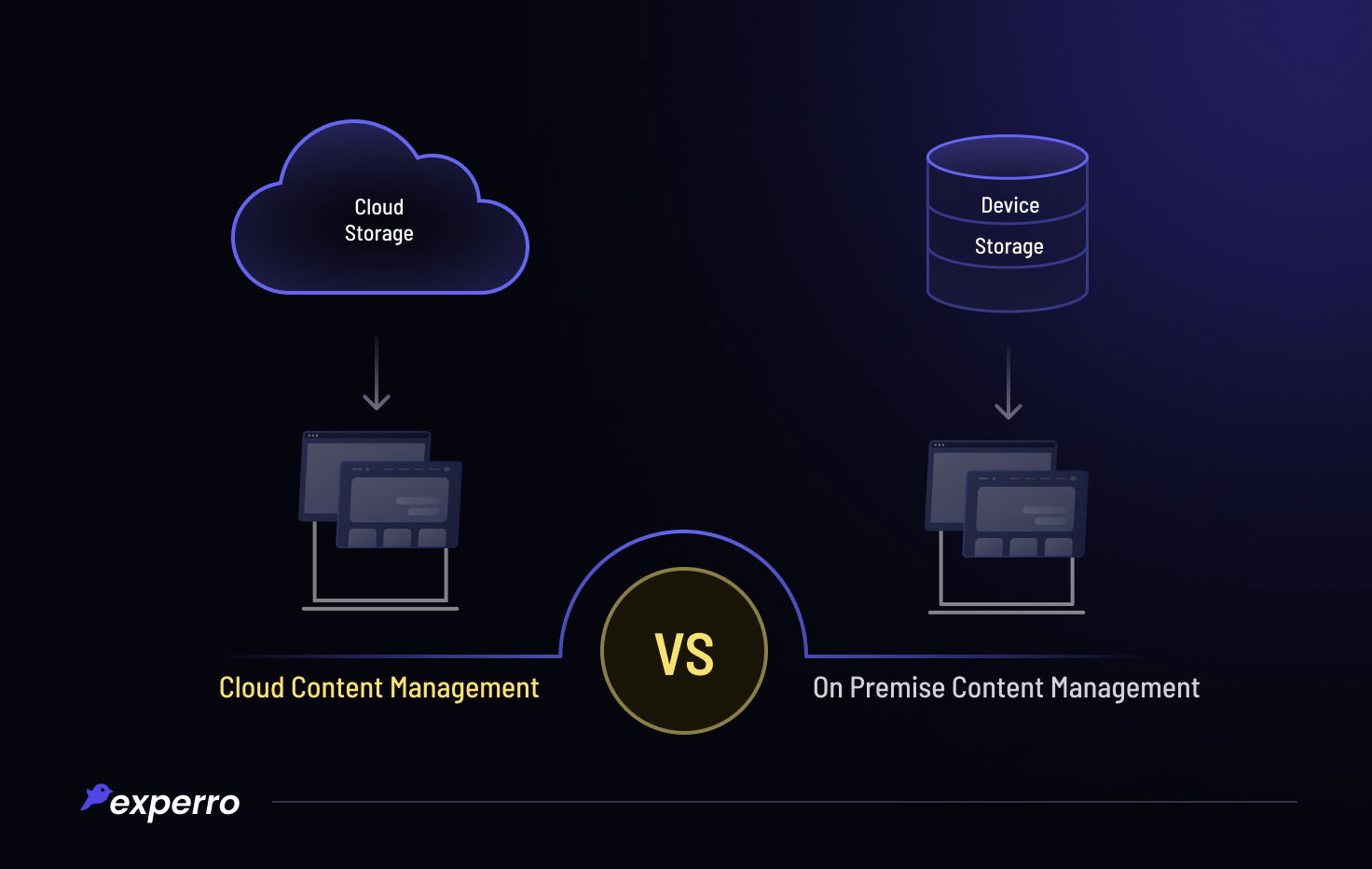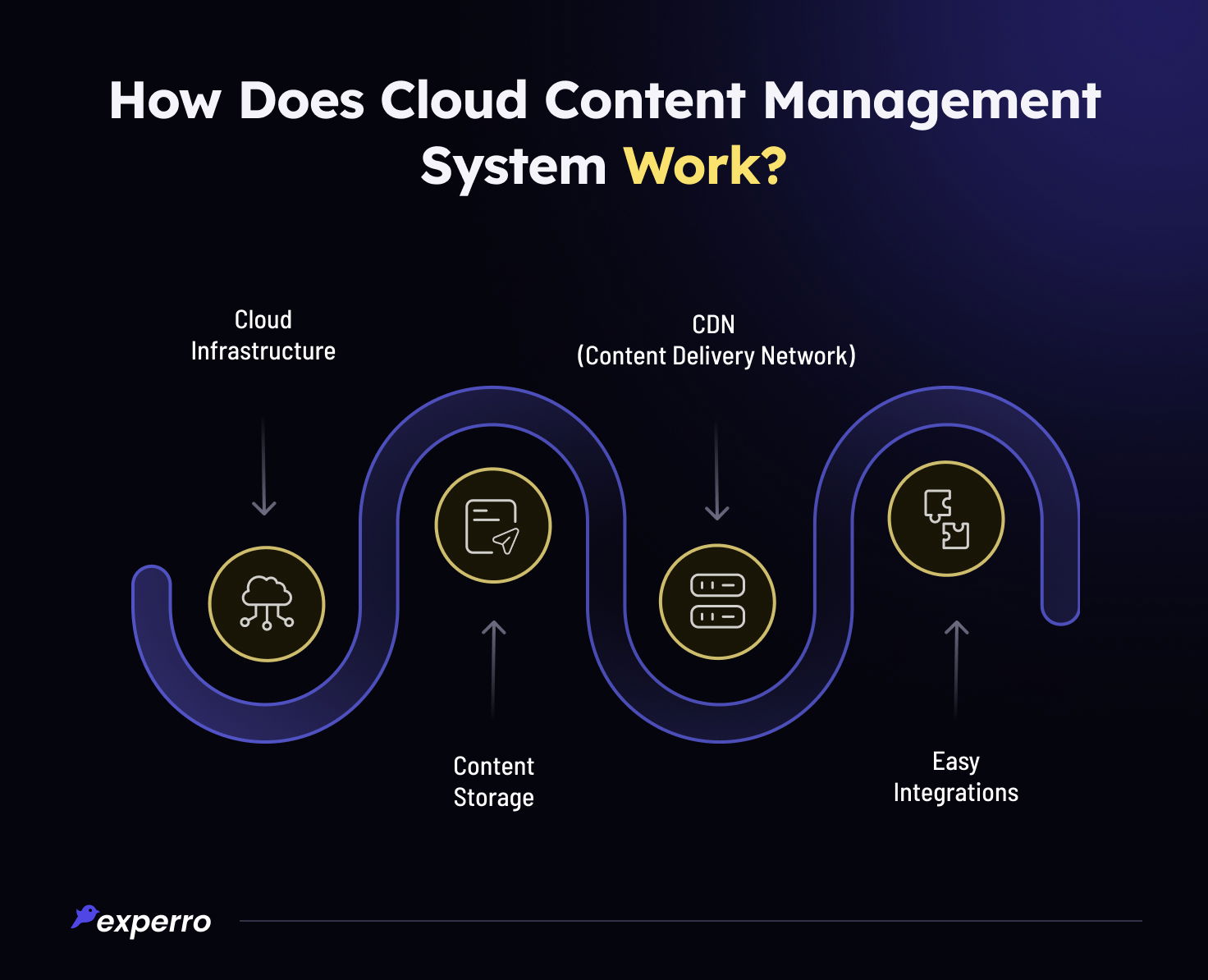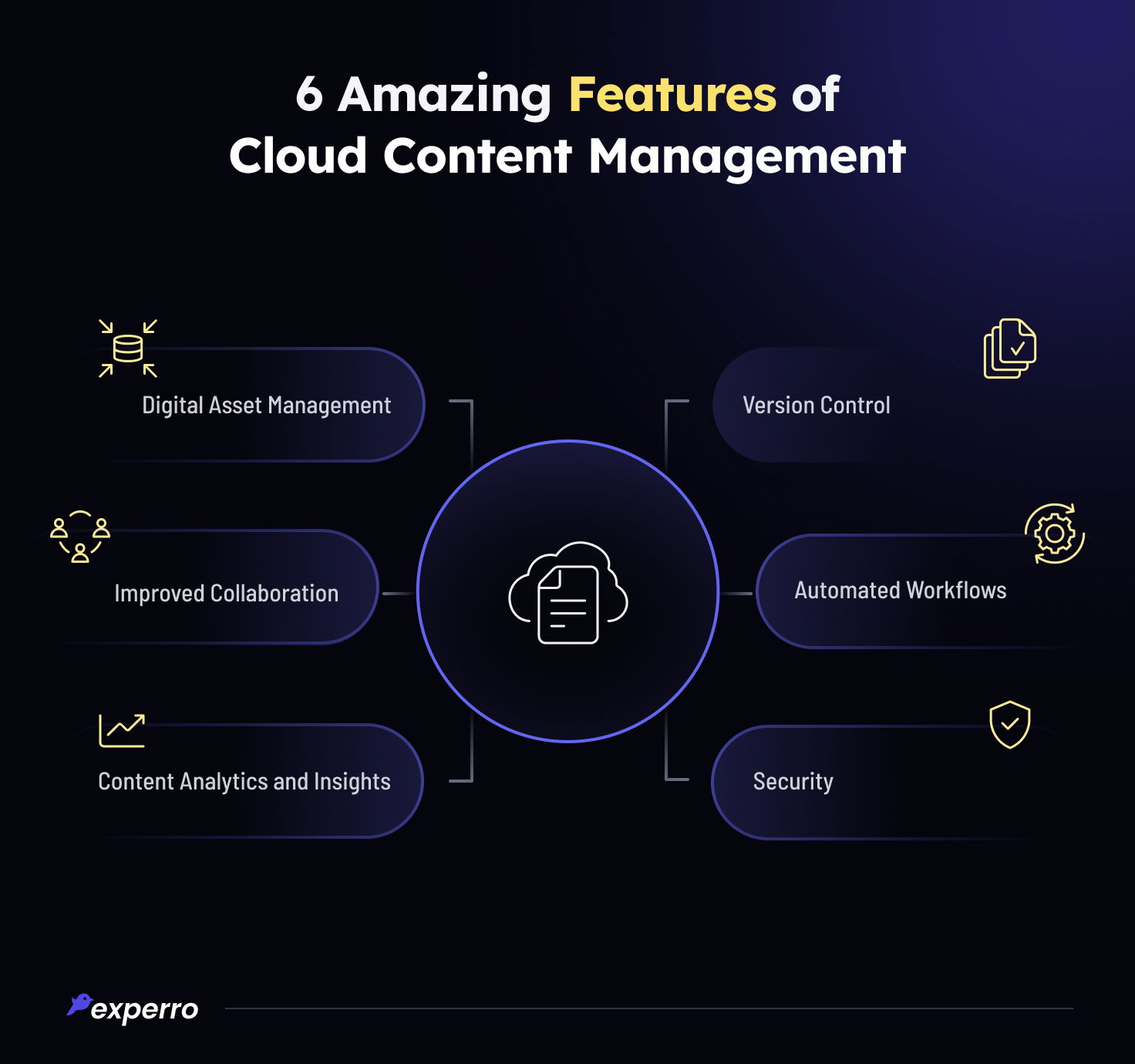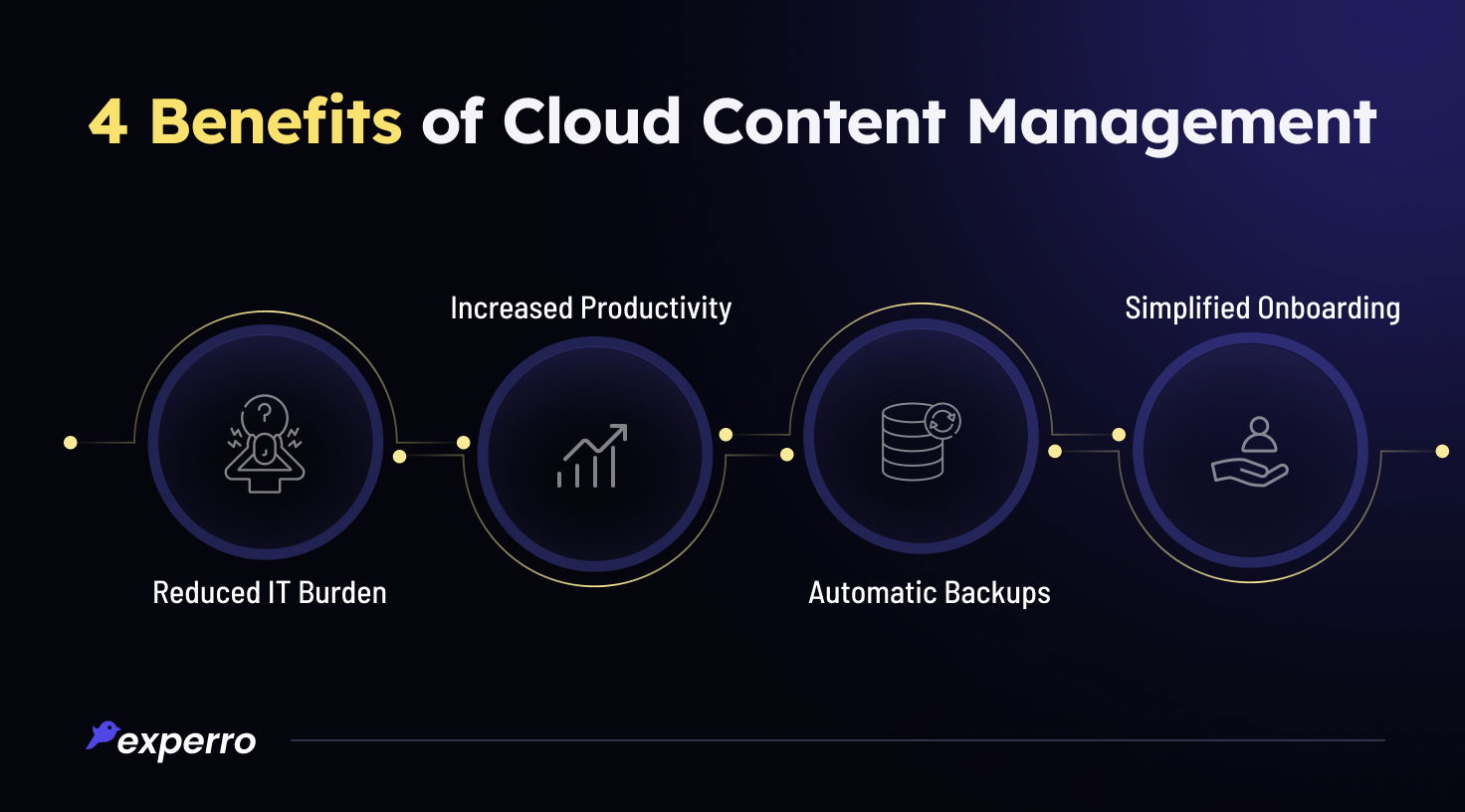Cloud Content Management in CMS: All You Need to Know!

What’s Inside
- What Is Cloud Content Management?
- Difference Between Cloud Content Management System & On Premise Content Management System
- How Does Cloud Content Management Platform Work?
- 6 Key Features of Cloud Content Management Systems
- 4 Essential Benefits of Cloud Base Content Management System
- Try The Best Cloud Content Management System in Town
- Stay Ahead of the Curve with Experro Cloud Content Management Platform
- What's COMING SOON In Experro?
- Create Content with Ease!
- Conclusion
Key Takeaways
- Cloud content management is a scalable solution for growing data needs and effective collaboration.
- CCM boosts productivity by enabling seamless collaboration and easy access to documents from anywhere.
- By offering an agile and efficient approach to managing content, cloud content management system reduces the extra workload on organizations and minimizes their dependence on IT support.
Just publishing content is not enough. Marketers need to keep up with trends at the speed of light. However, they are constantly racing against time, striving for timely execution of campaigns with quick coordination.
By the time a new campaign is ready to launch, the trend often loses its heat! 🔥🔥🔥
But what if teams could collaborate in real time, changes were updated swiftly, and approvals were streamlined?
Which means quick coordination and smooth workflow irrespective of the team’s geographical location.
All of this is possible with cloud content management.
Adopting a cloud-based content management system not only transforms the way teams operate but keeps organizations at the forefront of competitive edge. So, in this blog, we will dive deep into the meaning of cloud content management, its importance, and how organizations can benefit from it.
What Is Cloud Content Management?
Cloud content management refers to storing, managing, and ensuring workflow effectiveness within and outside of the organization. It allows organizations to manage content without the need for underlying server infrastructure.
Think of Google Photos, which stores all your pictures in the cloud, allowing you to access them from anywhere, anytime. Similarly, cloud CMS services safeguard all your data in the cloud, granting you access whenever needed.
However, the capabilities of cloud based management systems extend far beyond those of Google Photos for organizations.
Here is how - it handles everything from managing content to distributing it over multiple channels quickly. It allows organizations to access, collaborate, and manage their digital assets, maintaining robust security.
The hallmark of cloud content management? Uninterrupted access and collaboration, wherever and whenever you need!
Now that we have understood what is cloud content management let’s see how it differs from monolithic content management systems.
Difference Between Cloud Content Management System & On Premise Content Management System

Unlike cloud content management software, on-premises content management systems are hosted on an organization's local servers and infrastructure, often requiring manual updates and regular maintenance by the IT team.
The basic content management systems are not as effective as the cloud content management system. It has potential pitfalls and a lack of security.
Here's a tabulated difference between Cloud Content Management and on premises content management:
Feature/aspect | Cloud Content Management System | On Premise Content Management |
|---|---|---|
| Access | ✔️ Any device/location with internet connectivity. | Restricted to specific devices or networks. |
| Scalability | ✔️Easily scalable as business needs change. | Limited by hardware; expansion needs more investment. |
| Integration | ✔️Built-in capabilities with cloud platforms. | Requires custom development or third-party plugins. |
| Collaboration | ✔️Collaboration with instant updates. | Does not support real-time collaboration. |
| Maintenance | ✔️Minimal IT involvement, less downtime. | Manual updates; IT-intensive, potential downtime. |
| Workflow | ✔️Streamlines tasks, approvals, and processes. | Lacks advanced workflow tools; manual processes likely. |
How Does Cloud Content Management Platform Work?

Cloud content management software is built on various cloud computing models, including SaaS (Software as a Service), PaaS (Platform as a Service), or IaaS (Infrastructure as a Service), and CaaS (Content management as a Service) depending on their specific architecture and functionalities.
The cloud-based management systems store the digital content in remote servers hosted by cloud service providers. Such systems do the cloud based media asset management in one unified place.
It allows users to create content from various devices and locations, ensuring the files are available whenever needed.
From the points mentioned below, let’s understand how the cloud content management system works:
1. Cloud Infrastructure – No Need for External Servers
Cloud-based enterprise content management system provides network, storage, and resources required for server management. The infrastructure provides the foundational platform where the CMS runs. So, there is no need to manage servers through an external provider.
With data centers located worldwide, they ensure high availability and resilience, meaning the CMS can operate 24x7 without interruptions and automatically recover from failures.
2. Content Storage - Single Content Repository
Organizations often face challenges when they have multiple storage locations. Without a centralized location, tracking changes and collaborating is next to impossible.
However, with a centralized content repository of cloud content management, organizations can have a single source of truth!
Single cloud-based content storage ensures consistency and effective business processes without the risk of errors. From marketing materials to sensitive data, it keeps everything in one place.
The cloud content also means this storage is scalable on demand, accommodating growing amounts of data without needing physical hardware upgrades.
3. CDN (Content Delivery Network) - Delivering Content at Light's Pace!
With a cloud based CMS, organizations can enable content delivery with CDN distribution. The servers deliver content to users quickly, in different locations and multiple digital channels.
When users request content, it is delivered from the nearest CDN server, ensuring quick loading time. This is especially crucial for businesses that cater to a larger user base and diverse audience.
4. Easy Integrations - Bridging Gaps Effortlessly
Content management systems that do not offer integration with third-party applications become limiting for the organization and hinder specific growth.
A cloud headless CMS is built with modern architectures that readily support integrations with other cloud-based tools, marketing automation tools, and analytics platforms.
Third-party applications often provide specific features or functions and integrating them can enhance your existing capabilities and improve your team’s productivity.
Moreover, integrating with these apps can help your organization stay competitive and adapt to the changing digital landscape without the need for extensive development and cost.
6 Key Features of Cloud Content Management Systems

Features of cloud content management (CCM) addresses organizations' specific needs and challenges in managing their digital content.
Let's dive deeper into each content management cloud feature:
1. Digital Asset Management - Assets at Your Fingertips
Did you know? 98% of organizations use cloud-based software to manage digital assets.
The cloud content management system efficiently manages digital assets.
By streamlining the workflow and distribution of assets such as images, videos, and documents it enhances the organization's operational efficiency.
Leveraging cloud infrastructure ensures that these digital assets are easily accessible and manageable for every member of the organization, no matter where they are located.
2. Improved Collaboration - The Next Level of Teamwork
A total of 86% of employees in leadership positions blame lack of collaboration as the top reason for workplace failures.
Collaboration is the heart of cloud content management systems.
Multiple users can work on the same document simultaneously without creating any disruptions with remote content collaboration. And imagine, that too with real-time content editing and preview feature to see the live changes in front of the marketers.
As we all know, no marketing campaign can work without effective collaboration between team members. CCM platforms provide real-time collaboration tools.
Team members can simultaneously work on a document, view changes in real-time, comment, and even chat.
Effective collaboration removes the need for back-and-forth emails and ensures everyone is on the same page, quite literally.
3. Content Analytics and Insights - Know What Customers Want!
The first step to winning the audience’s hearts is to understand them.
Knowing what users want enables organizations to cater to their specific requirements rather than just assuming.
Content analytics and insights are important for organizations to implement data-driven decision-making. With Analytics and insights, organizations can better understand the audience's wants, behavior, and interests. Moreover, organizations can ensure which content is more effective and which needs improvement.
This improves the organization's content marketing efforts and allows it to reach the target audience and improve conversions.
4. Version Control - Every Change, Captured
Version control feature of cloud content management enables multiple team members to work on the same project simultaneously without hampering each other's productivity.
It maintains a history of changes made on each file and project. So, there is no room for mistakes with version control. Users can see the changes made to the file and easily revert to the previous version if needed.
5. Automated Workflows - Say Bye to Repetitive Tasks
"The future belongs to those who master automation, not manual repetition."
Automated workflows ensure the tasks are executed consistently according to predefined rules and standards. Employees can focus on more value-added tasks as routine and time-consuming activities are automated.
Let's say a piece of content needs approval from a manager before publication. Instead of manually sending it, waiting, reminding, and then publishing, a CCM can automate this. Once the content is ready, the system can send it for approval.
Once approved, it can be automatically published. This streamlines operations, reduces the chance of human error, and ensures consistency in processes.
6. Security - Safeguarding Data
A recent IBM report says 51% of organizations are planning to increase security investments because of a breach.
Data security is the bedrock upon which organizational trust and integrity are built. Without it, business operations are jeopardized, and so is the reputation of the enterprise.
Cloud-based content management system ensures robust security. When data is transferred between the organization's users, that means data is stored in the server, encrypted, and has delicious room for security threats.
4 Essential Benefits of Cloud Base Content Management System

Cloud content management provides several benefits to the organizations. Some of the key benefits are as follows:
1. Reduced IT Burden
Maintaining on-premises servers and taking the help of IT in day-to-day operational tasks becomes frustrating for organizations.
However, with the cloud content management system, organizations don’t need to rely on the underlying server infrastructure from the third-party provider. Instead, A cloud CMS provider takes care of servers.
This means that the IT team can focus on strategic innovations aligning with your business to drive growth and revenue rather than day-to-day operational tasks.
2. Increased Productivity
Without a cloud-based infrastructure, it is difficult for team members to collaborate effectively and maintain daily operations with a breeze.
Completion of tasks takes time, and deadlines often get overdue. However, with the cloud content management systems, your team can easily access, edit collaborate on documents from anywhere, whether they are in the office home or on the go.
3. Automatic Backups
Data loss can be troublesome for businesses. Just think about the peace of mind with automatic data backups. In case of any errors or accidental data loss, your content or data is safe with the cloud-based content management system. Every version of your file is stored in the cloud.
4. Simplified Onboarding
Cloud content management systems simplify the onboarding process for new employees. They can quickly access the new materials they need, from drilling materials to completing policies in the organizations in a user-friendly way.
Stay Ahead of the Curve with Experro Cloud Content Management Platform
Experro, headless CMS is a cloud-based content management platform that comes with headless architecture. Headless here means the application's frontend (presentation layer) and backend (content library) are totally separated.
Headless architecture is a new-age concept that is more flexible and agile than the monolithic CMS. So, headless architecture content can be easily repurposed for website mobile apps and different digital channels, enhancing your organization’s omnichannel presence and increasing efficiency.
Moreover, as new channels and technologies emerge, a headless CMS cloud can adapt it more easily, ensuring your content remains relevant and accessible.
What's COMING SOON In Experro?
Content Search: Similar to the product search, our search bar helps users quickly find specific blogs, white papers, and other documents on the site. It can also search within these documents using keywords.
Content Reporting: Allows organizations to create custom dashboards and analyze content performance for a data-driven approach.
Conclusion
It’s all about simplifying your content management system, and your team's productivity will increase. In a world where information is taking flight, cloud content management stands as a powerful ally. Adopt marketer-friendly system that streamlines content creation and distribution.
Book a demo with Experro to simplify your content management task and get discovered by your target audience with a breeze.
FAQs


Priya Zala
27 June 2024Through her writing, she has a lovely way of capturing users' pain points and delivering solution-oriented content. Her writing is sure to captivate readers and leave them with a lasting impression. When not crafting content, Priya enjoys getting lost in a good work of fiction, which soothes her soul.